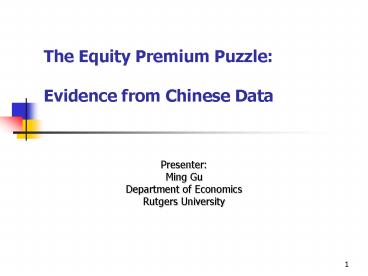The Equity Premium Puzzle: Evidence from Chinese Data - PowerPoint PPT Presentation
1 / 20
Title:
The Equity Premium Puzzle: Evidence from Chinese Data
Description:
... are quarterly observations of closing prices on the Shanghai Stock Exchange ... (2) Series D: Real quarterly dividends rate for the SSE's series. ... – PowerPoint PPT presentation
Number of Views:59
Avg rating:3.0/5.0
Title: The Equity Premium Puzzle: Evidence from Chinese Data
1
The Equity Premium PuzzleEvidence from Chinese
Data
- Presenter Ming GuDepartment of
EconomicsRutgers University
2
Abstract
- In this paper I have used 199503-200606 Chinese
quarterly data to evaluate the existence of an
equity premium puzzle. - I have concluded that the model used by Mehra and
Prescott (1985) is not able to satisfactorily
rationalize the equity premium observed in the
Chinese data - Such a conclusion was obtained both under
assumptions of lognormality or under simulations
based on a discrete state approximation of the
Markov process implied by the data.
3
The Previous Literature
- Mehra and Prescott (1985)
- Weil(1989)
- Mehra (2003)
4
Basic Model(1)
- We consider a frictionless economy that has a
single representative 'stand-in' household. -
(1)
5
Basic Model(2)
- The utility function is further restricted to be
of the constant relative risk aversion (CRRA)
class - (2)
- where the parameter a measures the curvature of
the utility function. When a 1, the utility
function is defined to be logarithmic, which is
the limit of Equation 2 asa approaches 1.
6
Basic Model(3)
- Assume one productive unit that produces in
period t output Yt , which is the period
dividend. - There is one equity share with price Pt
(denominated in consumption units) that is
competitively traded. - We can easily find the fundamental pricing
relationship (Lucas 1978) -
(3)
7
Basic Model(4)
- Equation 3 is used to price both stocks and
riskless one-period bonds. - For equity, (4)
- For riskless one-period bond
(5) - the expected gross return on equity
-
(6)
8
Methodology(1)
- Lognormality Test
- These assumptions are as follows
9
Methodology(1) cont
- Since the growth rates of consumption and
dividends are assumed to be lognormally
distributed -
(7) -
(8) - Where
10
Methodology(2)
- I stick to basic model , assuming that the growth
rate of the endowment follows a Markov process.
The method is given by Mehra and Prescott (1985). - The approach is to generate an approximation of
the initial problem using two states for Xt (real
per capita consumption growth rate) and a
transition matrix T of the approximating
discrete-state Markov chain.
11
Methodology(2) cont
- This particular parameterization was selected
because it permitted us to independently vary the
average growth rate of output by changing µ, the
variability of consumption by altering d, and the
serial correlation of growth rates by adjusting f
12
Empirical study(1)
- The Chinese data used in this work has a
quarterly frequency and ranges from 199503 to
200606.The data tested below are quarterly
observations of closing prices on the Shanghai
Stock Exchange - The series are individually described below
- (1) Series P Quarterly average SSE Composite
Stock Price Index divided by the Consumption
Deflator. - (2) Series D Real quarterly dividends rate for
the SSEs series. - (3) Series PC Consumption deflator series
- (4) Series RF Nominal three-month deposit rate
13
Empirical study(2)
- The quarterly return for time t
- the real return on a relatively riskless security
- the Risk Premium is calculated as the difference
between the Real Return on SSE and the Real
Return on a Riskless security as defined above.
14
Empirical study(3)
15
Empirical study(4)
16
Empirical study(5)
- We can thus raise the question If we set
risk-aversion coefficient a to be 10 and ß to be
0.99, what are the expected rates of return and
the risk premium using the parameterization - just described?
- which implies an equity risk premium of 0.47
percentage points far lower than the 1.43
percentage points historically observed.
17
Empirical study(6)
- Note that in this calculation, I was very liberal
in choosing the values for a and ß .Most studies
indicate a value for a that is close to 2. If I
were to pick a lower value for ß , the risk-free
rate would be even higher and the premium lower. - So, the 0.47 pp value represents the maximum
equity risk premium that can be obtained, given
the constraints on a and ß. This result
demonstrates the existence of the equity premium
puzzle under the assumption of lognormality.
18
Empirical study(7)
19
Empirical study(8)
- Given the estimated process on consumption,
figure 4 shows the set of values of the average
risk-free rate and equity risk premium which are
both consistent with the model and result in
average real risk-free rates between zero and
three percent. - These are values that can be obtained by varying
preference parameters a between zero and ten and
ß between zero and one. The observed real return
of 0.97 percent and equity premium of 1.43
percent is clearly inconsistent with the
predictions of the model. The largest premium
obtainable with the model is 0.49 percent, which
is not close to the observed value. - This result demonstrates the equity premium
puzzle in the China market again.
20
Conclusion and extension
- I have concluded that premium puzzle does exist
in the Chinese data both under assumptions of
lognormality and under simulations based on a
discrete state approximation of the Markov
process implied by the data. - Future work alternative model are used to
reinvestigated the existence of equity premium
puzzle.

